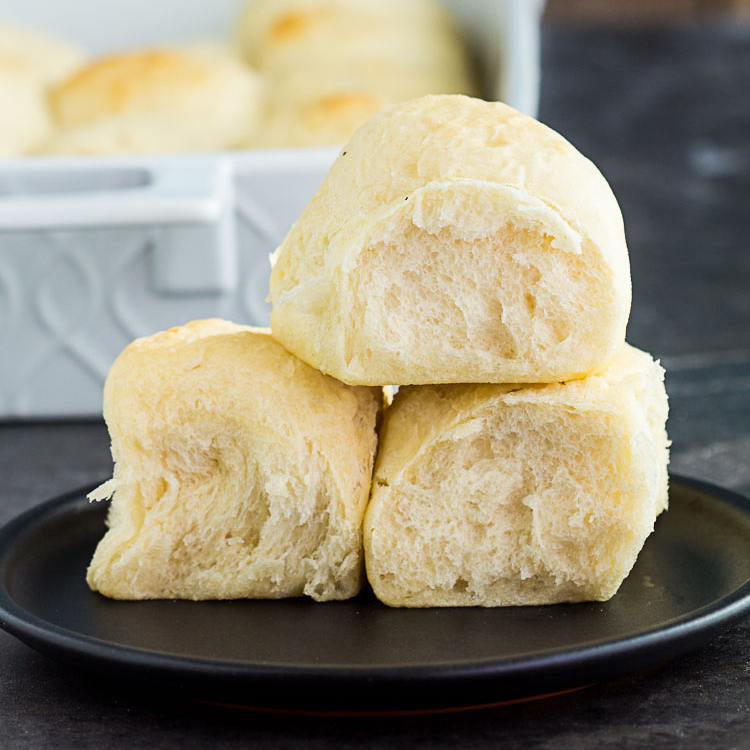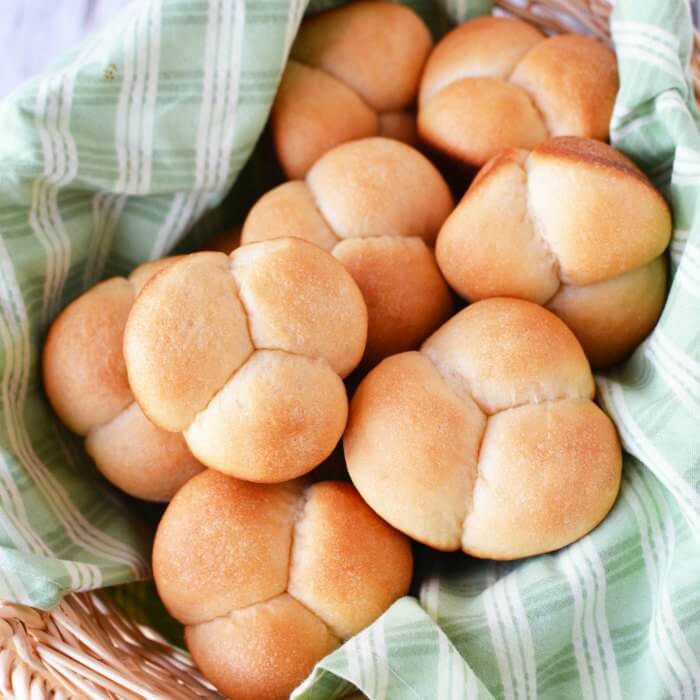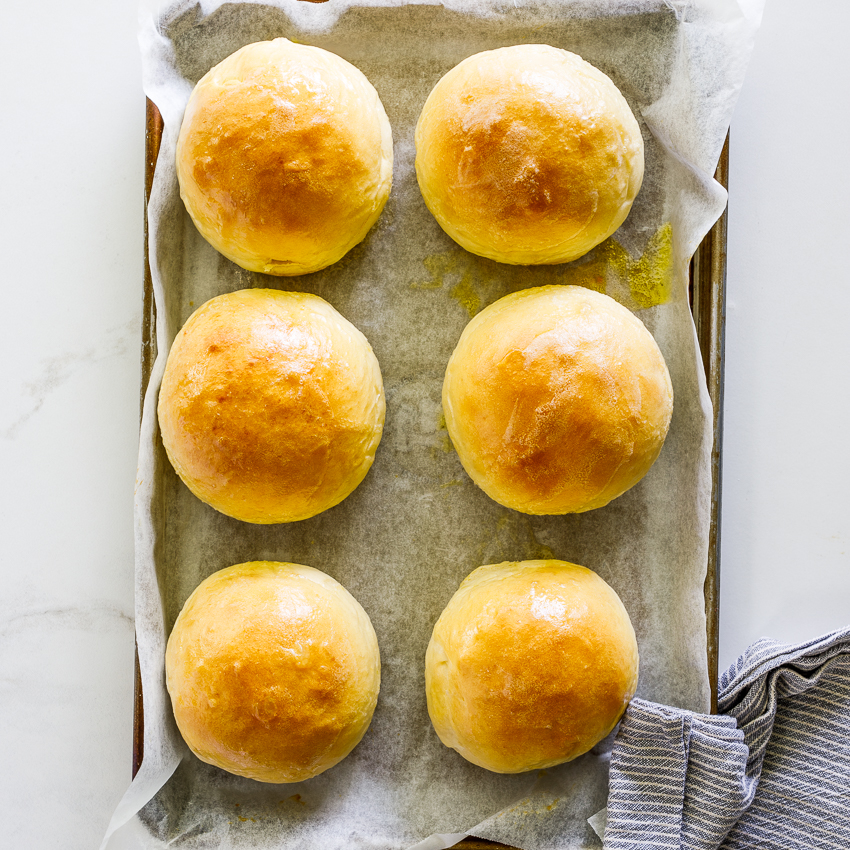Easy Homemade Dinner Rolls: A Simple and Delicious Recipe
Easy Homemade Dinner Rolls: A Simple and Delicious Recipe
Easy homemade dinner rolls are a delightful addition to any meal. Their soft, fluffy texture and golden-brown crust appeal to everyone. Making dinner rolls from scratch can be a rewarding experience. With a few simple ingredients and minimal effort, anyone can create these delicious rolls. This blog provides a step-by-step guide to making easy homemade dinner rolls that will impress family and friends.
Ingredients Needed for Dinner Rolls
To make easy homemade dinner rolls, gather essential ingredients. Start with four cups of all-purpose flour. This type of flour provides the necessary structure and texture for the rolls. Additionally, use one packet of active dry yeast or about two and a quarter teaspoons. Yeast is crucial for leavening, helping the rolls rise beautifully.
Next, prepare a cup of warm water. The water should be around 110°F (43°C). This temperature activates the yeast effectively, ensuring proper rising. Adding two tablespoons of sugar acts as food for the yeast. This process enhances the flavor and promotes fermentation.
Moreover, include a teaspoon of salt for flavor. Salt not only enhances taste but also strengthens the gluten structure. Using a quarter cup of unsalted butter adds richness and flavor to the rolls. The butter should be melted before using.
Lastly, for an egg wash, prepare one egg and a tablespoon of water. This mixture adds a beautiful, golden finish to the rolls once baked. Ensure all ingredients are measured and ready before beginning the dough-making process. Having everything prepared simplifies the process and enhances the experience of making dinner rolls.
These basic ingredients will yield delicious, fluffy dinner rolls. Following the recipe step-by-step will ensure successful results. With everything in place, it is time to start making the rolls.

Preparing the Dough for Dinner Rolls
Preparing the dough for easy homemade dinner rolls begins with activating the yeast. In a mixing bowl, combine warm water and sugar. Whisk these ingredients together until the sugar dissolves. Then, add the packet of yeast. Allow the mixture to sit for about five to ten minutes. This step allows the yeast to foam and bubble, confirming it is active.
Once the yeast is activated, combine the melted butter and salt in a separate large bowl. Stir these ingredients together, ensuring they are well mixed. After that, pour the activated yeast mixture into the bowl with the butter and salt. Mix well to combine all the ingredients thoroughly.
Next, gradually add the flour, one cup at a time. Using a wooden spoon or spatula, stir the mixture until it forms a soft dough. The dough should start to come together but may still be slightly sticky. If necessary, add additional flour in small amounts to achieve the desired consistency.
Once the dough forms into a soft ball, it is time to knead. Transfer the dough to a lightly floured surface. Knead the dough for about five to seven minutes. This process develops gluten, resulting in fluffy, airy rolls.
During kneading, the dough should become smooth and elastic. This texture indicates proper gluten development. After kneading, shape the dough into a ball and place it in a greased bowl. Cover the bowl with a clean kitchen towel. Allow the dough to rise in a warm area until it doubles in size, typically one to two hours.
Shaping the Dinner Rolls
Shaping the dinner rolls is an exciting part of the baking process. After the dough has risen and doubled in size, it is ready for shaping. Start by gently punching down the dough to release air bubbles. This step ensures even distribution of gas bubbles throughout the dough.
Next, turn the dough out onto a lightly floured surface. Divide the dough into equal pieces using a sharp knife or a dough cutter. For standard dinner rolls, aim for pieces weighing about two ounces each. This size will create perfectly portioned rolls that are easy to handle.
Now, shape each piece of dough into a ball. To do this, gently pull the edges of the dough towards the center. Pinch to seal the edges and create a smooth surface. Once the dough piece is shaped, roll it gently in your hands to form a perfect ball.
As each roll is shaped, place it in a greased baking dish or on a lined baking sheet. Be sure to leave some space between the rolls, as they will expand during the second rise and baking. Continue shaping and placing the rolls until all dough has been used.
After shaping, cover the rolls with a clean kitchen towel to allow them to rise again. Let them rest in a warm area for about 30 to 45 minutes. During this time, the rolls will puff up, becoming light and airy. This second rise is vital for achieving fluffy dinner rolls.
Baking the Dinner Rolls
Baking the easy homemade dinner rolls is an exciting process that results in delightful aromas. Preheat the oven to 375°F (190°C) while the rolls complete their second rise. This temperature is perfect for achieving a golden crust and soft interior.
Once the rolls have risen and doubled in size, it’s time to prepare for baking. For added flavor and shine, apply an egg wash to the rolls. To create the egg wash, beat one egg with a tablespoon of water. Use a pastry brush to gently brush the mixture over the tops of the rolls.
This step enhances the visual appeal, giving rolls a polished finish. It also helps improve browning during baking. If desired, sprinkle a pinch of sea salt or herbs on top before baking for extra flavor.
Next, carefully place the baking dish or sheet into the preheated oven. Bake the rolls for about 20 to 25 minutes. Keep an eye on the rolls as they bake, ensuring they do not overbrown.
The rolls are done when they are golden brown and sound hollow when tapped on the bottom. A thermometer inserted into the center should read around 190°F (88°C). Once baked, remove the rolls from the oven and let them cool slightly in the pan.

Enjoying Homemade Dinner Rolls
Enjoying easy homemade dinner rolls is the most rewarding part of the baking process. The delightful aroma and warm appearance of freshly baked rolls create anticipation. These rolls are perfect for accompanying various dishes, such as soups, stews, or salads.
To serve the dinner rolls, carefully remove them from the baking dish. Placing them on a cooling rack allows excess steam to escape, maintaining the crust’s texture. Rolls can be enjoyed warm, but they are equally delicious at room temperature.
For an extra touch, consider brushing melted butter over the warm rolls once they are out of the oven. This step enhances flavor and creates a beautiful sheen. Additional toppings, such as garlic or herb butter, can also be added to elevate the taste.
Dinner rolls can also be served with a variety of dips, such as hummus, olive oil, or flavored butter. These complementary spreads enhance the overall dining experience and provide flavor variations.
Storing any leftover rolls is easy due to their simple composition. Place cooled rolls in an airtight container or a resealable plastic bag. Storing at room temperature ensures they stay soft and fresh for several days.
Overall, enjoying homemade dinner rolls is a satisfying experience. They are not only delicious but also versatile enough to enhance any meal. Their comforting nature brings warmth and joy to family and friends.
Variations on Easy Homemade Dinner Rolls
Exploring variations on easy homemade dinner rolls adds excitement and creativity to the baking process. Changing ingredients and flavors can create unique rolls suited for different tastes. By incorporating various elements, individuals can create a customized experience.
One popular variation involves adding herbs and garlic to the dough. Chopped fresh herbs like rosemary, thyme, or parsley bring aromatic flavors to the rolls. Mixing in minced garlic enhances the savory profile, making them perfect for accompaniments to hearty meals.
Another option is to include cheese in the rolls. Cheddar, mozzarella, or feta can be folded into the dough before shaping. This addition creates deliciously cheesy rolls that melt in the mouth, making them irresistible.
For those with a sweet tooth, incorporating cinnamon and sugar can create delightful sweet rolls. Mixing brown sugar and cinnamon into the dough adds an aromatic touch. Drizzling icing on top of the baked rolls provides a sweet finish, ideal for breakfast or dessert.
Additionally, experimenting with whole wheat or gluten-free flour can cater to special dietary needs. This adaptation ensures that everyone can enjoy freshly baked rolls, regardless of dietary restrictions. Adjusting the recipe to accommodate various flours may require additional liquid or binding agents.
By exploring these variations, individuals can create rolls that suit any occasion. Customizing the basic recipe encourages creativity and fosters a sense of adventure in the kitchen. Each variation provides a unique twist, making easy homemade dinner rolls even more enjoyable.

Tips for Successful Homemade Dinner Rolls
Implementing tips for successful homemade dinner rolls enhances the baking experience. These strategies ensure that the rolls turn out fluffy and delicious every time. Following these guidelines helps avoid common pitfalls in the baking process.
First, measuring ingredients accurately is essential for consistent results. Using a kitchen scale can help ensure proper proportions, especially for flour. This precision is crucial for achieving the right dough consistency, leading to perfect rolls.
Furthermore, pay attention to the yeast’s activation. Ensuring the water temperature is just right is critical. Water that is too hot can kill the yeast, while water that is too cold may not activate it. Keeping the water around 110°F (43°C) provides the ideal environment for successful fermentation.
Additionally, allow sufficient time for the dough to rise. Rushing the rising process can result in dense, flat rolls. Instead, allow the dough to rise until it doubles in size for the best texture and flavor.
Kneading the dough adequately is also vital. Proper kneading develops gluten, which contributes to the fluffy texture. Kneading for five to seven minutes should create a smooth, elastic dough, indicating good gluten development.
Lastly, remember that different ovens may require adjustments in baking time or temperature. Always keep an eye on the rolls during baking and adjust accordingly. Conducting the “hollow tap test” helps identify if the rolls are fully baked.
By implementing these tips, the process of making easy homemade dinner rolls becomes much smoother. This guidance ensures successful results, allowing anyone to enjoy delicious, freshly baked rolls. The joy of sharing homemade dinner rolls with loved ones adds to the overall satisfaction of baking.
Conclusion: The Joy of Homemade Dinner Rolls
Easy homemade dinner rolls bring warmth and joy to every dining table. Their delightful aroma and fluffy texture create a comforting atmosphere. The satisfaction of making these rolls from scratch fosters a sense of accomplishment.
Whether paired with soups, stews, or served alongside a holiday feast, dinner rolls elevate any meal. Their versatility and adaptability cater to various tastes and preferences. Customizing recipes allows for endless creativity, making baking fun and enjoyable.
Utilizing simple ingredients makes this recipe accessible to everyone. With a little effort, anyone can achieve beautiful results. The caring preparation of homemade dinner rolls enhances the overall dining experience. It provides immediate gratification and brings loved ones together.
Furthermore, sharing homemade rolls connects individuals through the simple act of enjoying food together. This timeless tradition can lead to cherished memories, creating a sense of belonging in families and communities. Embracing this delightful recipe brings joy to everyday life.
Ultimately, making easy homemade dinner rolls is a rewarding experience. They not only nourish the body but also uplift the spirit. The process of baking rolls becomes a celebration of love, creativity, and togetherness. Enjoying these delightful creations nurtures connections, making every meal a special occasion.
